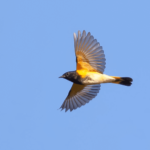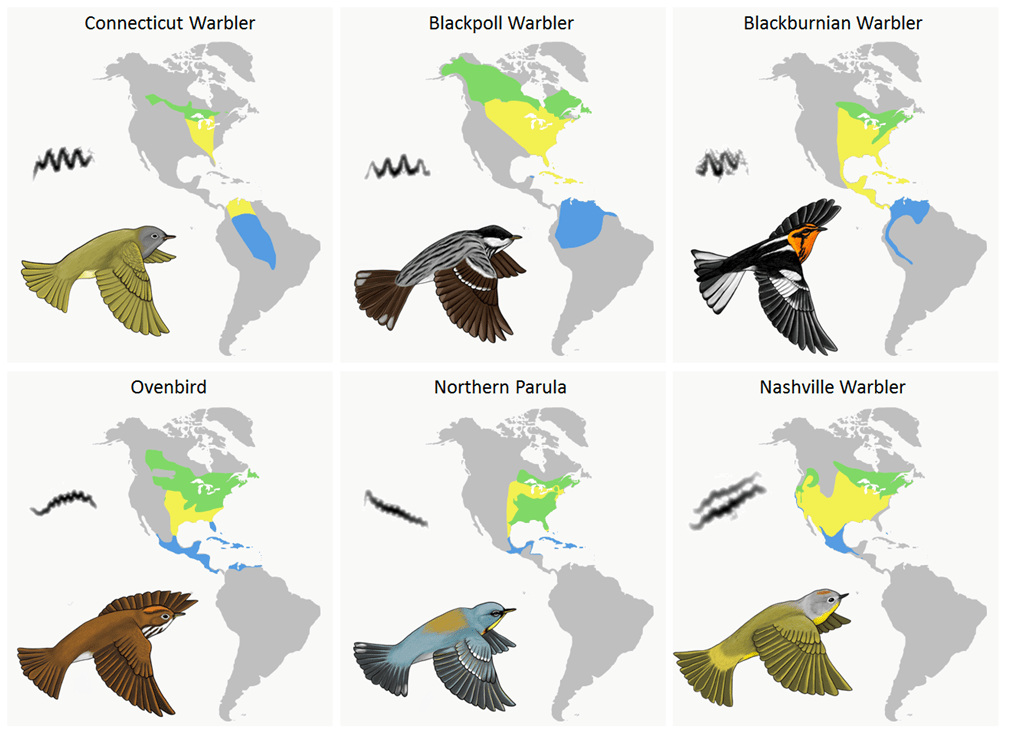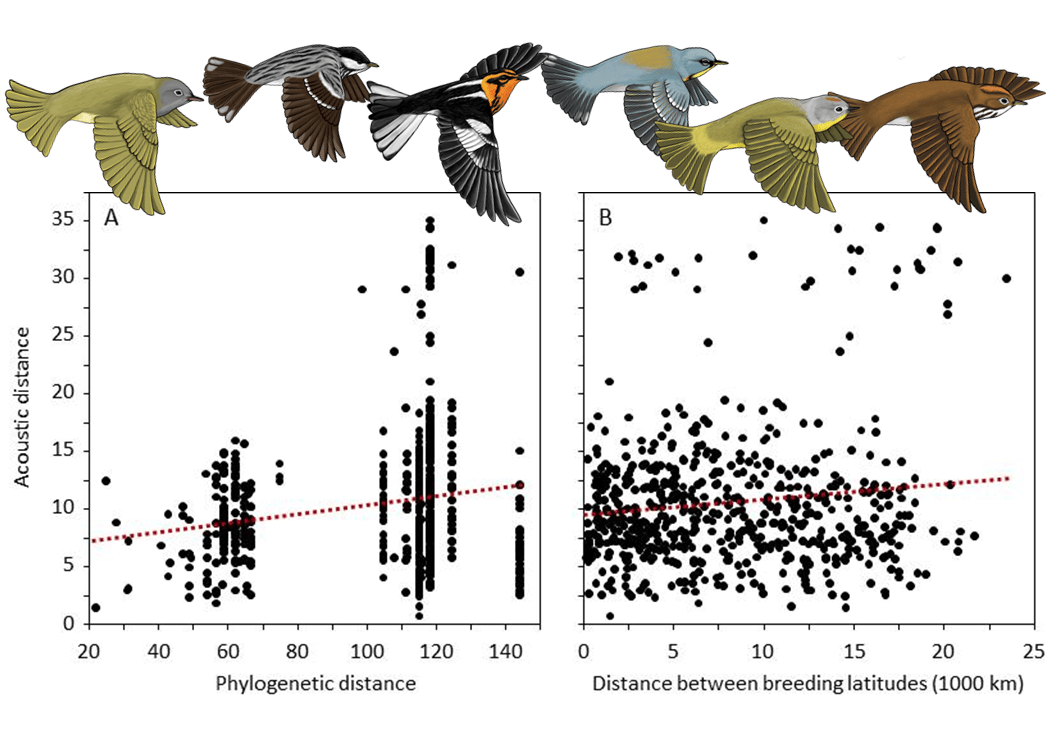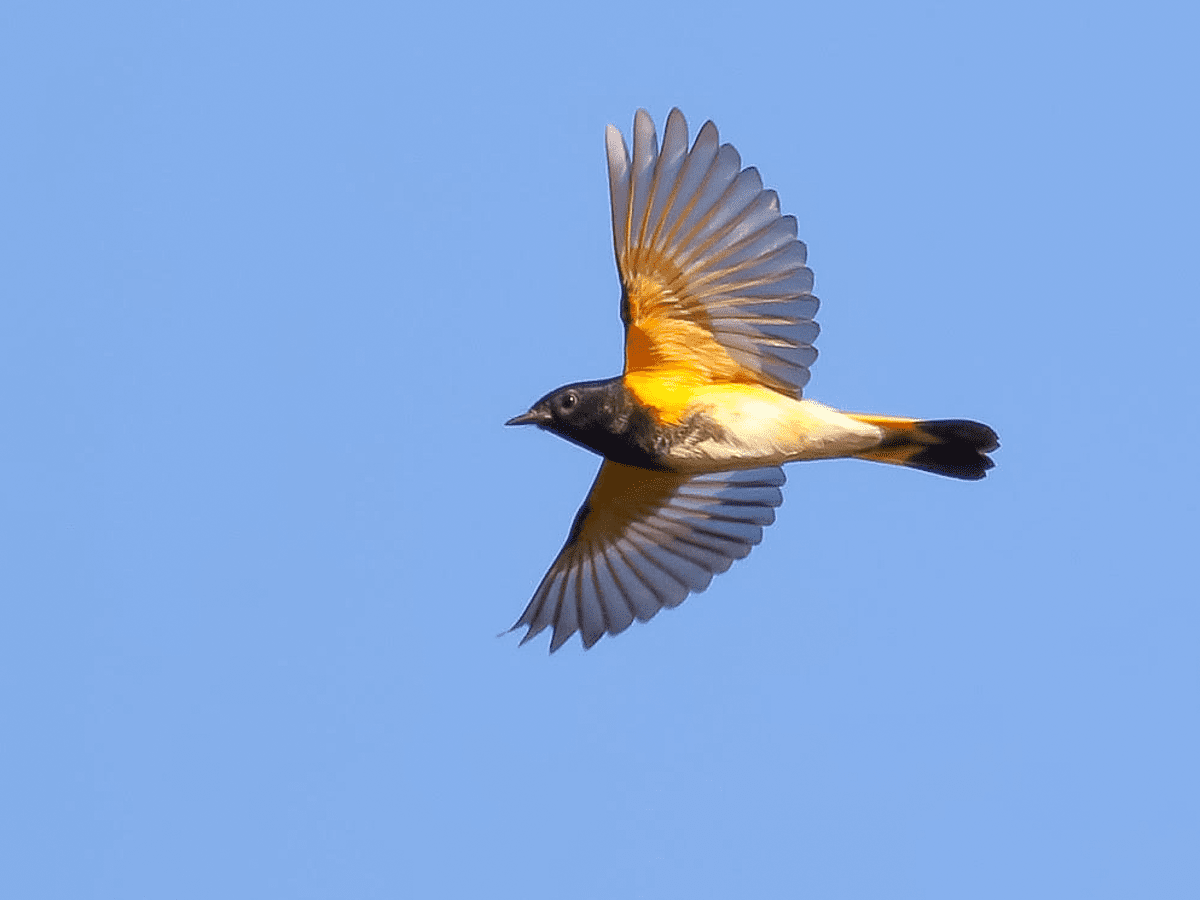LINKED PAPER
The evolution of wood warbler flight calls: species with similar migrations produce acoustically similar calls. Gayk, Z.G., Simpson, R.K., Mennill, D.J. 2021 Evolution. DOI: 10.1111/evo.14167 VIEW
 Billions of birds migrate each year between northern breeding grounds and southern wintering areas. As they fly under the cover of darkness, many songbirds produce quiet sounds known as “flight calls”. The function of these short calls has puzzled scientists for more than a century. Orin Libby, in 1899, wrote one of the first descriptions of flight calls in North America:
Billions of birds migrate each year between northern breeding grounds and southern wintering areas. As they fly under the cover of darkness, many songbirds produce quiet sounds known as “flight calls”. The function of these short calls has puzzled scientists for more than a century. Orin Libby, in 1899, wrote one of the first descriptions of flight calls in North America:
The air seemed at times fairly alive with invisible birds as the calls rang out… Almost human many of them seemed, too, and it was not difficult to imagine that they expressed a whole range of emotions from anxiety and fear up to good-fellowship and joy. It was a marvel and a mystery enacted under the cover of night, and of which only fugitive tidings reached the listeners below.
An astute listener will realise that many songbird species produce very similar flight calls, even unrelated species. This raises the question: Why do some songbirds have similar-sounding flight calls, while other species sound quite different?
 Figure 1 Range maps and sound spectrograms of flight calls for six species of North American wood warblers. Warbler illustrations by Lauren Szucki.
Figure 1 Range maps and sound spectrograms of flight calls for six species of North American wood warblers. Warbler illustrations by Lauren Szucki.
While researchers have long recorded and counted flight calls to study migration, few conclusive reasons have been found for why songbirds make these calls as they travel through the night sky. Flight calls have been proposed to stimulate birds to migrate (Hamilton 1962), and to allow birds to remain together (Ball 1952). They have been suggested to be more similar among species occupying the same ecological habitats (Farnsworth and Lovette 2008), and to encode information about identity (Griffiths et al. 2016). However, we still lack a satisfactory explanation for why birds should utter these calls so frequently during migration, and a framework for understanding why flight calls are so similar between some species and so different between others.
Our study advances our understanding of songbird flight calls and the forces that may influence their evolution. Together with my coauthors—Dan Mennill, a Professor of Ornithology at the University of Windsor in Canada, and Rick Simpson, a Postdoctoral Researcher—I sought to investigate if overlap of warbler species in migration can explain the evolution of wood warbler flight calls. We predicted that species that overlap in both space and time during migration may have evolved acoustically similar calls as a means of identifying flockmates with similar migratory routes and timings. We predicted that warbler flight calls might be under selection to be similar in species that have similar migratory routes because it may be beneficial to remain with individuals travelling the same way.
 Figure 2 The author, Zach Gayk, analysing flight calls.
Figure 2 The author, Zach Gayk, analysing flight calls.
To test this idea we analysed the acoustic structure of 864 flight calls from 36 species of wood warblers. We collected fine-scale acoustic measurements for each flight call, and we used these measurements to calculate the acoustic similarity between each pair of species. Next, we gathered data on each species’ breeding range, migration zone, and wintering range, as well as the timing of their migrations. We harnessed a large dataset from citizen scientist records on the geographic overlap and timing of migration in the eBird and NatureServe databases. We then compared acoustic similarity of calls to the similarity in their migrations.
We were unsurprised to find a strong evolutionary signature in wood warbler flight calls: species with similar calls tended to be closely related. But we were surprised and excited to find that, after accounting for relatedness, birds with similar calls share similar migrations. We found that the flight calls of 36 species of migratory wood warblers are acoustically similar in species that overlap geographically and temporally during migration, independently of how closely related the species are. Across all warbler species, wood warblers with more similar breeding latitudes and timings of May migration had more similar flight calls.
After analysing across the entire group of wood warblers, we looked specifically at a group of warblers known for having confusingly similar flight calls (the “Zeep Complex”). Within this complex, we found that several distantly related species of warblers in this group that have similar long-distance migration routes to South American wintering grounds have extremely similar flight calls. In this group, wood warblers with similar lengths of migrations and similar target wintering destinations had acoustically similar flight calls.
 Figure 3 Plots of acoustic similarity and phylogenetic distance (a measure of evolutionary relatedness between species pairs) and geographic overlap (a measure of breeding range similarity). Warbler illustrations by Lauren Szucki.
Figure 3 Plots of acoustic similarity and phylogenetic distance (a measure of evolutionary relatedness between species pairs) and geographic overlap (a measure of breeding range similarity). Warbler illustrations by Lauren Szucki.
Our results are exciting because we show, for the first time, that flight calls may have evolved to be acoustically convergent in species with similar migrations. For example, it is intriguing that at least two species—the Blackpoll Warbler and the Connecticut Warbler—have nearly identical flight calls and both travel nonstop across the ocean between Canada and their South American wintering grounds (Deluca et al. 2015, McKinnon et al. 2017). Bird species exhibiting such extreme migratory journeys may benefit from a means of differentiating short distance migrants that they may encounter during their migratory journey. Our findings suggest that wood warblers may have evolved acoustically convergent calls in this group and provides a hint into how birds may use flight calls.
Our study suggests that multiple species of migratory warblers may use flight calls to communicate during migration. Other groups of songbirds, such as sparrows (Passerellidae) and buntings (Cardinalidae) appear to have acoustically similar calls, although more quantitative research is needed. It would be interesting to see if the same patterns drive the evolution of flight calls in other groups of birds.
What are the next steps for research on flight calls? Behavioural observations of calling warblers during migration may help us to understand the context of their flight calls. The use of 3D microphone arrays may be particularly helpful in this regard (Gayk and Mennill 2019). If we use a 3D microphone array to record passing flocks of migrants, we can examine which species fly together in migration, whether acoustically similar species fly together, and how different species’ flight calls transmit through the air.
Imagine travelling thousands of kilometres though the night sky. Birds are profoundly isolated from other birds visually, but by calling with each other, they can remain in contact. Over time, it appears that flight calls evolved to sound similar among the species they migrated with. It may be that songbirds use these calls as acoustic cues indicating which individuals are travelling the same way, the avian equivalent of airline pilots on a radio.
References
Ball, S.C. 1952. Fall bird migration in the Gaspé Peninsula. Peabody Museum of Natural History, Yale University Bulletin 7.
DeLuca, W.V., Woodworth, B.K., Rimmer, C.C., Marra, P.P., Taylor, P.D., McFarland, K.P., Mackenzie, S.A. & Norris, D.A. 2015. Transoceanic migration by a 12 g songbird. Biology Letters 11: 20141045. VIEW
Farnsworth, A. & Lovette, I.J. 2008. Phylogenetic and ecological effects on interspecific variation in structurally simple vocalizations. Biological Journal of the Linnean Society 94: 155–173. VIEW
Gayk, Z.G & Mennill, D.J. 2019. Pinpointing the position of flying songbirds with a wireless microphone array: three-dimensional triangulation of warblers on the wing. Bioacoustics 29: 317–386. VIEW
Griffiths, E.T., Keen, S.C., Lanzone, M., & Farnsworth, A. 2016. Can nocturnal flight calls of the migrating songbird, American Redstart, encode sexual dimorphism and individual identity? PLoS ONE 11: e0156578. VIEW
Hamilton, W.J. 1962. Evidence concerning the function of nocturnal call notes of migratory birds The Condor 64: 390-401. VIEW
Libby, O.G. 1899. The nocturnal flight of migrating birds Auk 16: 140–145.
McKinnon, E.A., Artuso, C. & Love, O.P. 2017. The mystery of the missing warbler Ecology 98: 1970–1972. VIEW
Image credit
Top right: An American Redstart (Setophaga ruticilla) in migration © Steve Kolbe





